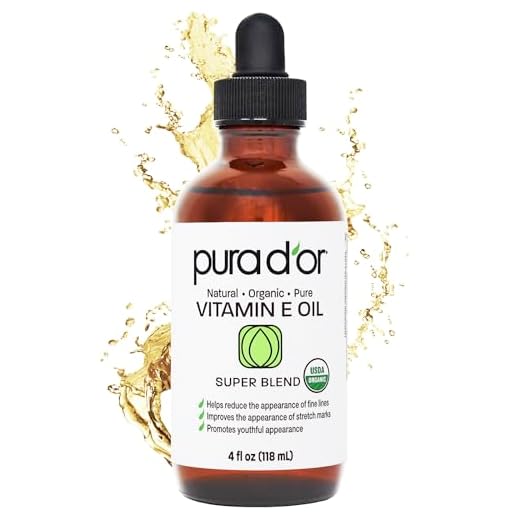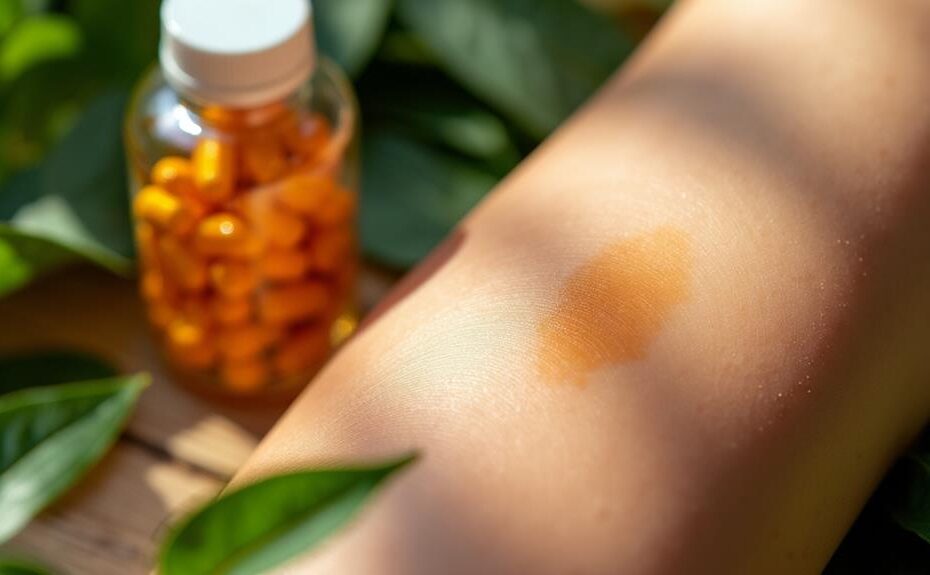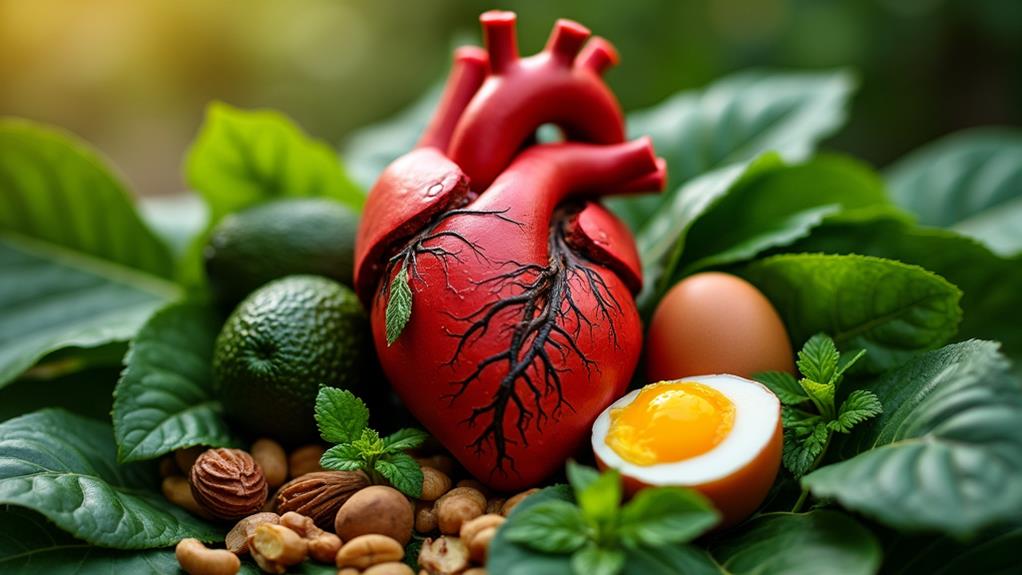







Vitamin E supplements have limited effectiveness for scar healing. Clinical studies show that about 90% of participants reported no improvement in surgical scars when using these supplements. While vitamin E is a well-known antioxidant important for skin health, its role in scar management is unclear. Topical vitamin E may provide hydration but can also cause allergic reactions like contact dermatitis. More effective alternatives exist, such as silicone sheets and laser therapy, which may yield better results. For a thorough understanding of scar treatment options and their efficacy, further information is essential.
Key Takeaways
- Clinical evidence shows limited support for vitamin E supplements in improving scar healing, with many participants reporting no significant improvement.
- Topical vitamin E may cause allergic reactions, such as contact dermatitis, in some individuals.
- High doses of vitamin E supplements can increase bleeding risks, particularly when combined with anticoagulants.
- Established scar management methods, like silicone sheets and laser therapy, may be more effective than vitamin E for scar treatment.
- Further research is necessary to clarify vitamin E's role in scar healing and its long-term effects.
Overview of Vitamin E
Vitamin E, an essential fat-soluble antioxidant, plays a pivotal role in skin health by protecting cells from oxidative stress caused by free radicals. This vitamin consists of tocopherols and tocotrienols, both of which exhibit considerable antioxidant properties that support skin repair and hydration. You can obtain Vitamin E from various dietary sources, including nuts, seeds, green leafy vegetables, and whole grains, highlighting the importance of nutrition over supplementation in maintaining skin health. Additionally, topical applications such as 365 by Whole Foods Market Vitamin E Oil provide deep hydration and may aid in reducing the visibility of scars and stretch marks.
Topical Vitamin E, often applied in the form of vitamin E oil, is widely recognized for its moisturizing effects. While it may enhance skin texture and hydration, the evidence regarding its effectiveness in scar healing remains inconclusive. Studies indicate that while some individuals report improvements in scar appearance with topical application, the results can vary considerably. Therefore, the assumption that Vitamin E can universally promote healing or reduce scar visibility lacks robust scientific backing. As you consider incorporating Vitamin E into your skincare routine, be aware of its potential benefits and limitations, emphasizing a holistic approach that includes both dietary intake and topical application for ideal skin health.
Evidence on Vitamin E and Scars
While topical applications of vitamin E have been popular for scar treatment, current research provides limited support for the effectiveness of vitamin E supplements in enhancing scar healing specifically. Evidence from clinical trials indicates mixed or inconclusive results regarding vitamin E's role in scar management. A notable study from 1999 revealed that 90% of participants using topical vitamin E reported no improvement in the appearance of surgical scars, with some even experiencing allergic reactions, highlighting the potential risks involved. However, products like Fruit Of The Earth Vitamin-E Oil may offer benefits for promoting healing of scars and enhancing skin hydration due to their concentrated formula.
Although vitamin E supplements may not directly improve scar healing, they could contribute to overall skin hydration and texture, which are essential for the healing process. The antioxidant benefits of vitamin E might support skin health in a more general sense, yet their efficacy specifically for scar healing remains unproven.
To establish definitive benefits of vitamin E for scar management, further clinical trials are necessary. Until stronger evidence emerges, relying solely on vitamin E supplements for scar healing may not be advisable, and individuals should consider alternative treatments that have demonstrated effectiveness.
Understanding Scarring and Healing
Scarring is a complex biological process that occurs as your body heals from injuries, surgeries, or skin conditions, resulting in changes to the skin's texture and appearance. The formation of scars involves an intricate interplay of inflammation and immune response, which can greatly influence the amount of scar tissue produced. In adults, a heightened immune response often leads to more prominent scars, while fetal wounds demonstrate minimal scarring. Additionally, the use of products like Nature's Truth Vitamin E Oil can support skin health, potentially aiding in the healing process.
The healing timeline varies; for example, fine-line scars may take up to two years to flatten, whereas hypertrophic scars can thicken for up to six months before gradually fading. Scar redness typically fades in about seven months, though individual factors and scar types can affect this duration.
Understanding these mechanisms is vital for effective scar management, as it helps in setting realistic expectations regarding cosmetic appearance over time. While vitamin E is often considered for its potential benefits in wound healing, its efficacy in scar reduction remains contested. Extensive knowledge of scarring and healing processes enables better treatment strategies and informed decisions regarding interventions aimed at improving the appearance of scars.
Alternative Scar Management Techniques
Effective management of scars requires a multifaceted approach, incorporating various techniques to maximize healing and improve appearance. One effective method is the use of silicone sheets, which hydrate scar tissue and have been shown to reduce collagen production when worn for at least 12 hours daily over three months. For larger scars, regular massage therapy can enhance appearance and diminish sensitivity through brief, consistent sessions.
Dermarolling, or microneedling, is another promising technique that stimulates the skin's healing processes and has demonstrated improvements in acne scars after just three treatment sessions. Additionally, laser therapy options such as pulsed-dye or CO2 lasers target blood vessels in scars, potentially promoting collagen production, although further research is necessary to confirm long-term efficacy.
While topical applications of vitamin E and other natural remedies like aloe vera and honey are popular, their effectiveness compared to these established methods is not fully validated. Consequently, it is crucial to explore these various scar management techniques to enhance your healing process and achieve superior results.
Application Methods for Vitamin E
Topical application of vitamin E can be an effective adjunct in scar management, particularly when utilized properly. You can apply vitamin E in oil or cream form directly onto the scar. To optimize absorption, it's recommended to massage the product into the affected area gently. Consistent application is essential; studies suggest that regular use over time may enhance the results, although individual responses can vary.
Before beginning, conducting a patch test is advisable to identify any allergic reactions, as some individuals may experience contact dermatitis. If you notice redness or irritation, discontinue use immediately.
Furthermore, you can enhance the efficacy of topical vitamin E by combining it with other treatments, such as silicone gel sheets or hydrocortisone. This multimodal approach may improve scar management outcomes, providing a synergistic effect.
While oral vitamin E supplements are available, they are generally not recommended for direct impact on scar healing, as topical application has shown more promising results in clinical practice. By adhering to these application methods, you can maximize the potential benefits of vitamin E in your scar healing journey.
Potential Risks of Vitamin E
When considering vitamin E for scar healing, it is vital to be aware of the potential risks associated with its use. High doses of vitamin E supplements can be harmful, with excessive intake exceeding 1,000 mg of natural or 670 mg of synthetic vitamin E posing significant health risks, including increased bleeding tendencies. In addition, clinical evidence supporting vitamin E's effectiveness in scar healing is limited, leaving many individuals unaware of its ineffectiveness and associated risks.
Topical application of vitamin E carries additional concerns; studies indicate that around one-third of participants developed contact dermatitis, highlighting the possibility of allergic reactions. If you're currently taking anticoagulant medications, caution is warranted. Vitamin E may interfere with these drugs, amplifying the risk of bleeding complications.
Given the lack of substantial clinical evidence regarding vitamin E's role in scar healing and the potential for adverse effects, it is important to consult a healthcare provider before initiating any supplementation. They can provide personalized advice based on your health status and needs, ensuring that you're making informed decisions regarding vitamin E and scar management.
Dietary Sources of Vitamin E
While considering the potential risks associated with vitamin E supplementation, it's important to recognize that dietary sources can provide a safer and more balanced approach to meeting your nutritional needs. Incorporating a variety of foods rich in vitamin E can help you achieve the recommended dietary allowance (RDA) of 15 mg per day for adults.
Nuts, particularly almonds and hazelnuts, are excellent sources of vitamin E. Additionally, seeds, such as sunflower seeds, contribute considerably to your intake. Green leafy vegetables like spinach and kale also offer substantial amounts of this essential nutrient. Whole grains, including wheat germ and oats, further enhance your vitamin E consumption.
Using healthy oils in your diet can boost vitamin E levels as well. Olive oil and sunflower oil are particularly high in this vitamin and can be easily integrated into cooking and salad dressings. Furthermore, many fortified foods, like certain breakfast cereals, are designed to help you meet your daily nutritional requirements more conveniently. By focusing on these dietary sources, you can guarantee ideal health while minimizing the potential risks associated with supplementation.
Summary of Research Findings
Research findings on vitamin E supplementation for scar healing reveal a complex landscape of efficacy and safety. While vitamin E may protect tissues from free radicals, its direct impact on scar healing remains unclear. Clinical trials indicate that topical application of vitamin E does not greatly improve scar appearance, with a study showing that 90% of participants reported no effect or worsening scars compared to a placebo. Remarkably, one-third of participants experienced contact dermatitis, underscoring potential adverse effects associated with topical use.
Some studies suggest that vitamin E could reduce scar thickness, particularly for newer scars, but results vary widely and lack consistency. The current consensus among dermatologists emphasizes that vitamin E supplements are not a standalone solution for effective scar management. The existing clinical evidence is insufficient to endorse vitamin E as a reliable treatment for scars, highlighting the need for further research to establish its efficacy. Until more conclusive findings emerge, relying solely on vitamin E for scar healing may not be advisable. Always consult a dermatologist for tailored advice and treatment strategies in scar management.
Future Directions in Research
The limitations of current research on vitamin E's effectiveness for scar healing underscore the need for more rigorous investigations. Future research should prioritize large-scale, randomized controlled trials that specifically evaluate the efficacy of vitamin E supplements in scar healing. Additionally, exploring the combined effects of vitamin E with other treatments, such as silicone gel sheets and retinoids, could yield valuable insights into more effective scar management strategies.
Special attention is warranted for pediatric populations, as existing research on vitamin E's effects on scar healing in children is limited. This gap in knowledge could greatly inform treatment protocols tailored for younger patients. Moreover, studies should investigate the underlying mechanisms of action by which vitamin E influences scar formation and healing processes at a cellular level.
Longitudinal studies evaluating the long-term effects of vitamin E supplementation across various types of scars could clarify its role in dermatological health. By addressing these focal points, future research can contribute to a more thorough understanding of vitamin E's potential in scar healing and enhance clinical practices in scar management.
Conclusion
While slathering vitamin E on your scars might seem like a quick fix, the evidence doesn't exactly support it as a miracle cure. Instead of dreaming of a world where vitamin E acts like a magic eraser for skin, consider exploring other proven scar management techniques. After all, expecting vitamin E to mend your scars is akin to hoping a band-aid will perform surgery. Embrace a more evidence-based approach to scar healing for the best results.







